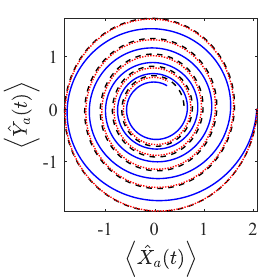Image

Lifetime renormalization of weakly anharmonic superconducting qubits. I. Role of number nonconserving terms
Publication Year
2020
Type
Journal Article
Abstract
The dynamics of a weakly anharmonic superconducting qubit in a complex electromagnetic environment is generally well described by an effective multimode Kerr Hamiltonian at sufficiently weak excitation. This Hamiltonian can be embedded in a master equation with losses determined by the details of the electromagnetic environment. Recent experiments indicate, however, that when a superconducting circuit is driven with microwave signals populating the system with sufficiently high excitations, the observed relaxation rates appear to be substantially different from expectations based on the electromagnetic environment of the qubit alone. This issue is a limiting factor in the optimization of superconducting qubit readout schemes. We claim here that an effective master equation with drive-power-dependent parameters is an efficient approach to model such quantum dynamics. In this sequence of papers, we derive effective master equations, whose parameters exhibit nonlinear dependence on the excitation level of the circuit as well as the electromagnetic environment of the qubit. We show that the number nonconserving terms in the qubit nonlinearity generally lead to a renormalization of dissipative parameters of the effective master equation, while the number conserving terms give rise to a renormalization of the system frequencies. Here, in Paper I, we consider the excitation-relaxation dynamics of a transmon qubit that is prepared in a certain initial state, but is not driven otherwise. A unitary transformation technique is introduced to study the renormalization of (i) qubit relaxation due to coupling to a generic bath and (ii) Purcell decay. Analytic expressions are provided for the dependence of the nonlinear dissipative terms on the details of the electromagnetic environment of the qubit. The perturbation technique based on unitary transformations developed here is generalized to the continuously driven case in Paper II [A. Petrescu et al., Phys. Rev. B 101, 134510 (2020)].
Journal
Physical Review B
Volume
101
Issue
13
Pages
134509
Date Published
04/2020
ISSN Number
2469-9950, 2469-9969
Documents
Publication groups
